
- Usage in publication:
-
- Ferriferous limestone (Vanport limestone)
- Modifications:
-
- Original reference
- Dominant lithology:
-
- Limestone
- AAPG geologic province:
-
- Appalachian basin
Summary:
Pg. 60-66. Ferriferous limestone (Vanport limestone). Massive limestone, fossiliferous, 1 to 15 feet thick. Overlain by Buhrstone iron ore. Lies 30 feet below Kittanning sandstone and shale and 25 to 55 feet above Clarion coal.
[GNC remark (ca. 1936, US geologic names lexicon, USGS Bull. 896, p. 2234): Adopted by the USGS as Vanport limestone member of Allegheny formation. Age is Pennsylvanian. Recognized in western PA and MD, eastern OH, and northern WV. Named from exposures at Vanport, Beaver Co., western PA.]
Source: US geologic names lexicon (USGS Bull. 896, p. 2234).
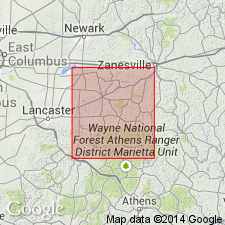
- Usage in publication:
-
- Vanport member
- Modifications:
-
- Revised
- Redescribed
- Dominant lithology:
-
- Chert
- Limestone
- Shale
- AAPG geologic province:
-
- Appalachian basin
Summary:
Pg. 44-45, table 1. Vanport member of Scrubgrass cyclothem in report on Perry County, eastern Ohio. Composed of either milky-colored flint or chert, crystalline limestone, sandy limestone, calcareous limestone, or very fossiliferous shale. Flint facies dominates all others, whereas limestone facies is more localized than any other. Thickness 4 inches to 2.5 feet. Overlies Scrubgrass coal. Underlies Ferriferous member, Allegheny series. [Age is Pennsylvanian.]
Source: US geologic names lexicon (USGS Bull. 1200, p. 4058).
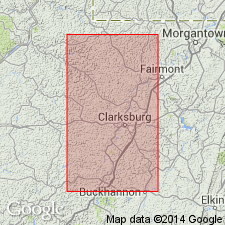
- Usage in publication:
-
- Vanport limestone
- Modifications:
-
- Areal extent
- AAPG geologic province:
-
- Appalachian basin
Summary:
Pg. 22 (table 5). Vanport limestone listed with recognizable members of Allegheny formation in Harrison County, West Virginia. [Age is Pennsylvanian.]
Source: US geologic names lexicon (USGS Bull. 1200, p. 4058).
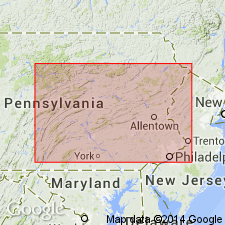
- Usage in publication:
-
- Vanport limestone member
- Modifications:
-
- Revised
- AAPG geologic province:
-
- Appalachian basin
Summary:
Pg. 910 (fig. 2). Vanport limestone member of Clarion formation. Above Clarion sandstone member and below Lower Kittanning sandstone. Allegheny group. [Age is Pennsylvanian.]
Source: US geologic names lexicon (USGS Bull. 1200, p. 4058).
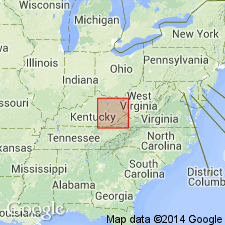
- Usage in publication:
-
- Vanport Limestone Member*
- Modifications:
-
- Revised
- AAPG geologic province:
-
- Appalachian basin
Summary:
Extended to KY and revised as Vanport Limestone Member of Breathitt Formation in area of report.
Source: GNU records (USGS DDS-6; Reston GNULEX).
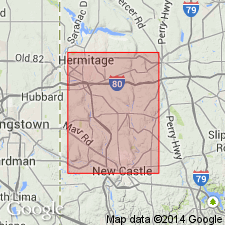
- Usage in publication:
-
- Vanport Limestone*
- Modifications:
-
- Revised
- AAPG geologic province:
-
- Appalachian basin
Summary:
Revised as Vanport Limestone of Allegheny Group in report area.
Source: GNU records (USGS DDS-6; Reston GNULEX).
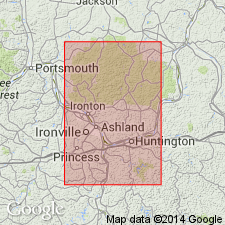
- Usage in publication:
-
- Vanport limestone
- Modifications:
-
- Revised
- AAPG geologic province:
-
- Appalachian basin
Summary:
In Kentucky, Vanport Limestone Member of Breathitt Formation is given informal status and will be referred to as Vanport Limestone Member as used by Phalen (1912).
Source: GNU records (USGS DDS-6; Reston GNULEX).
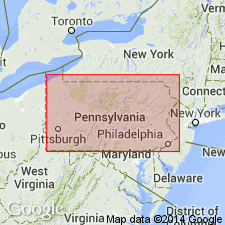
- Usage in publication:
-
- Vanport Limestone
- Modifications:
-
- Areal extent
- AAPG geologic province:
-
- Appalachian basin
Summary:
Used as Vanport Limestone of Allegheny Group.
Source: GNU records (USGS DDS-6; Reston GNULEX).
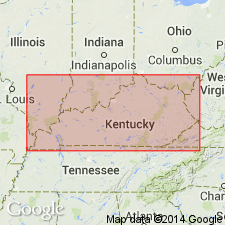
- Usage in publication:
-
- Vanport Limestone Member*
- Modifications:
-
- Areal extent
- AAPG geologic province:
-
- Appalachian basin
Summary:
Unit mapped as Vanport Limestone Member as used by Phalen (1912) of the Breathitt Formation. Age is Middle Pennsylvanian.
Source: GNU records (USGS DDS-6; Reston GNULEX).
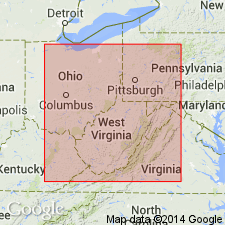
- Usage in publication:
-
- Vanport Limestone Member*
- Modifications:
-
- Overview
- AAPG geologic province:
-
- Appalachian basin
Summary:
Western facies of Vanport Limestone Member of Allegheny Formation in central OH is cherty. In northern OH, it is discontinuous and covered by glacial deposits in some of the area between Flint Ridge and Lowellville. On the basis of stratigraphic position, Vanport Limestone Member in central OH (Zaleski and Flint Ridge areas) is correlated with Zaleski Flint Member of Wanless (1939, 1975) of Allegheny Formation in southern OH (Shawnee and Flint Ridge areas). Vanport appears to merge with Putnam Hill Limestone Member of Allegheny Formation in northeastern OH and western PA. In southern OH, a similar merger with overlying Zaleski Flint Member. Thus, Vanport in most of PA is probably a single, uninterrupted marine-bay deposit while an earlier transgression (represented by Putnam Hill Limestone Member in OH, Kilgore Flint Member of Breathitt Formation in KY, Limekiln limestone of Johnston (1962) and Flint Ridge flint of Morse (1931) of Breathitt Formation, and Kanawha black flint of Wanless (1939, 1975) of Kanawha Formation in WV) resulted in deposits extending far south into KY and WV. A later, more limited transgression is represented by Vanport Limestone Member and its southernmost extension, Zaleski Flint Member. Correlatives of Vanport and Zaleski do not occur in eastern KY or WV because of nondeposition. Preliminary analyses of conodonts in Putnam Hill and Vanport Limestone Members in OH indicate that they have similar fauna and may represent parts of the same unit. Presence of fusulinid BEEDEINA LEEI (Skinner) in Putnam Hill in OH and in Vanport of PA indicates close temporal association. B. CARMANI (Thompson) was collected from both Vanport and Putnam Hill in OH.
Source: GNU records (USGS DDS-6; Reston GNULEX).
For more information, please contact Nancy Stamm, Geologic Names Committee Secretary.
Asterisk (*) indicates published by U.S. Geological Survey authors.
"No current usage" (†) implies that a name has been abandoned or has fallen into disuse. Former usage and, if known, replacement name given in parentheses ( ).
Slash (/) indicates name conflicts with nomenclatural guidelines (CSN, 1933; ACSN, 1961, 1970; NACSN, 1983, 2005, 2021). May be explained within brackets ([ ]).

